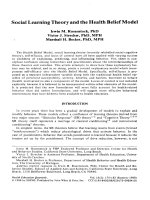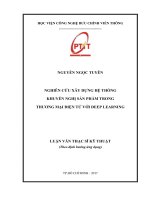Deep learning theory
Bạn đang xem bản rút gọn của tài liệu. Xem và tải ngay bản đầy đủ của tài liệu tại đây (22.8 MB, 50 trang )
Deep
Learning
Theory
Yoshua
Bengio
April
15,
2015
London
&
Paris
ML
Meetup
Breakthrough
•
Deep
Learning:
machine
learning
algorithms
based
on
learning
mul:ple
levels
of
representa:on
/
abstrac:on.
Amazing
improvements
in
error
rate
in
object
recogni?on,
object
detec?on,
speech
recogni?on,
and
more
recently,
some
in
machine
transla?on
2
Ongoing Progress: Natural Language
Understanding
• Recurrent
nets
genera?ng
credible
sentences,
even
beCer
if
condi?onally:
• Machine
transla?on
Xu
et
al,
to
appear
ICML’2015
• Image
2
text
Why is Deep Learning
Working so Well?
4
Machine Learning, AI
& No Free Lunch
• Three
key
ingredients
for
ML
towards
AI
1. Lots
&
lots
of
data
2. Very
flexible
models
3. Powerful
priors
that
can
defeat
the
curse
of
dimensionality
5
Ultimate Goals
• AI
• Needs
knowledge
• Needs
learning
(involves
priors
+
op#miza#on/search)
• Needs
generaliza:on
(guessing
where
probability
mass
concentrates)
• Needs
ways
to
fight
the
curse
of
dimensionality
(exponen?ally
many
configura?ons
of
the
variables
to
consider)
• Needs
disentangling
the
underlying
explanatory
factors
(making
sense
of
the
data)
6
ML 101. What We Are Fighting Against:
The Curse of Dimensionality
To
generalize
locally,
need
representa?ve
examples
for
all
relevant
varia?ons!
Classical
solu?on:
hope
for
a
smooth
enough
target
func?on,
or
make
it
smooth
by
handcraZing
good
features
/
kernel
Not Dimensionality so much as
Number of Variations
(Bengio, Dellalleau & Le Roux 2007)
• Theorem:
Gaussian
kernel
machines
need
at
least
k
examples
to
learn
a
func?on
that
has
2k
zero-‐crossings
along
some
line
• Theorem:
For
a
Gaussian
kernel
machine
to
learn
some
maximally
varying
func?ons
over
d
inputs
requires
O(2d)
examples
Putting Probability Mass where
Structure is Plausible
• Empirical
distribu?on:
mass
at
training
examples
• Smoothness:
spread
mass
around
• Insufficient
• Guess
some
‘structure’
and
generalize
accordingly
9
Bypassing the curse of
dimensionality
We
need
to
build
composi?onality
into
our
ML
models
Just
as
human
languages
exploit
composi?onality
to
give
representa?ons
and
meanings
to
complex
ideas
Exploi?ng
composi?onality
gives
an
exponen?al
gain
in
representa?onal
power
Distributed
representa?ons
/
embeddings:
feature
learning
Deep
architecture:
mul?ple
levels
of
feature
learning
Prior:
composi?onality
is
useful
to
describe
the
world
around
us
efficiently
10
Non-distributed representations
Clustering
• Clustering,
n-‐grams,
Nearest-‐
Neighbors,
RBF
SVMs,
local
non-‐parametric
density
es?ma?on
&
predic?on,
decision
trees,
etc.
• Parameters
for
each
dis?nguishable
region
• #
of
dis:nguishable
regions
is
linear
in
#
of
parameters
à
No
non-‐trivial
generaliza?on
to
regions
without
examples
11
The need for distributed
representations
• Factor
models,
PCA,
RBMs,
Neural
Nets,
Sparse
Coding,
Deep
Learning,
etc.
• Each
parameter
influences
many
regions,
not
just
local
neighbors
• #
of
dis:nguishable
regions
grows
almost
exponen:ally
with
#
of
parameters
• GENERALIZE
NON-‐LOCALLY
TO
NEVER-‐SEEN
REGIONS
Mul?-‐
Clustering
C1
C2
input
12
C3
Non-‐mutually
exclusive
features/
aCributes
create
a
combinatorially
large
set
of
dis?nguiable
configura?ons
Classical Symbolic AI vs
Representation Learning
• Two
symbols
are
equally
far
from
each
other
• Concepts
are
not
represented
by
symbols
in
our
brain,
but
by
paCerns
of
ac?va?on
(Connec/onism,
1980’s)
Geoffrey
Hinton
Output
units
Hidden
units
Input
units
13
person
cat
dog
David
Rumelhart
Neural Language Models: fighting one
exponential by another one!
• (Bengio
et
al
NIPS’2000)
i−th output = P(w(t) = i | context)
output
softmax
...
...
Exponen?ally
large
set
of
generaliza?ons:
seman?cally
close
sequences
most computation here
tanh
...
C(w(t−n+1))
...
R(w1 ) R(w2 ) R(w3 ) R(w4 ) R(w5 ) R(w6 )
w1
14
w2
w3
w4
w5
input sequence
w6
...
Table
look−up
in C
index for w(t−n+1)
C(w(t−2))
...
...
C(w(t−1))
...
Matrix C
shared parameters
across words
index for w(t−2)
index for w(t−1)
Exponen?ally
large
set
of
possible
contexts
Neural word embeddings – visualization
Directions = Learned Attributes
15
Analogical Representations for Free
(Mikolov et al, ICLR 2013)
• Seman?c
rela?ons
appear
as
linear
rela?onships
in
the
space
of
learned
representa?ons
• King
–
Queen
≈
Man
–
Woman
• Paris
–
France
+
Italy
≈
Rome
France
Italy
Paris
Rome
16
Summary of New Theoretical Results
• Expressiveness
of
deep
networks
with
piecewise
linear
ac?va?on
func?ons:
exponen?al
advantage
for
depth
(Montufar
et
al
NIPS
2014)
• Theore?cal
and
empirical
evidence
against
bad
local
minima
(Dauphin
et
al
NIPS
2014)
• Manifold
&
probabilis?c
interpreta?ons
of
auto-‐encoders
• Es?ma?ng
the
gradient
of
the
energy
func?on
(Alain
&
Bengio
ICLR
2013)
• Sampling
via
Markov
chain
(Bengio
et
al
NIPS
2013)
• Varia?onal
auto-‐encoder
breakthrough
(Gregor
et
al
arXiv
2015)
17
The Depth Prior can be Exponentially
Advantageous
Theore?cal
arguments:
2 layers of
Logic gates
Formal neurons
RBF units
= universal approximator
RBMs & auto-encoders = universal approximator
Theorems on advantage of depth:
(Hastad et al 86 & 91, Bengio et al 2007,
Bengio & Delalleau 2011, Braverman 2011,
Pascanu et al 2014, Montufar et al NIPS 2014)
Some functions compactly
represented with k layers may
require exponential size with 2
layers
…
2n
1
2
3
…
1
2
3
n
subroutine1 includes
subsub1 code and
subsub2 code and
subsubsub1 code
subroutine2 includes
subsub2 code and
subsub3 code and
subsubsub3 code and …
main
“Shallow” computer program
subsubsub2
subsubsub1
subsub1
subsub2
sub1
sub2
main
“Deep” computer program
subsubsub3
subsub3
sub3
Sharing Components in a Deep
Architecture
Polynomial
expressed
with
shared
components:
advantage
of
depth
may
grow
exponen?ally
Sum-‐product
network
Theorems
in
(Bengio
&
Delalleau,
ALT
2011;
Delalleau
&
Bengio
NIPS
2011)
New theoretical result:
Expressiveness of deep nets with
piecewise-linear activation fns
(Pascanu,
Montufar,
Cho
&
Bengio;
ICLR
2014)
(Montufar,
Pascanu,
Cho
&
Bengio;
NIPS
2014)
Deeper
nets
with
rec?fier/maxout
units
are
exponen?ally
more
expressive
than
shallow
ones
(1
hidden
layer)
because
they
can
split
the
input
space
in
many
more
(not-‐independent)
linear
regions,
with
constraints,
e.g.,
with
abs
units,
each
unit
creates
mirror
responses,
folding
the
input
space:
22
A Myth is Being Debunked: Local
Minima in Neural Nets
! Convexity is not needed
• (Pascanu,
Dauphin,
Ganguli,
Bengio,
arXiv
May
2014):
On
the
saddle
point
problem
for
non-‐convex
op/miza/on
• (Dauphin,
Pascanu,
Gulcehre,
Cho,
Ganguli,
Bengio,
NIPS’
2014):
Iden/fying
and
aWacking
the
saddle
point
problem
in
high-‐
dimensional
non-‐convex
op/miza/on
• (Choromanska,
Henaff,
Mathieu,
Ben
Arous
&
LeCun
2014):
The
Loss
Surface
of
Mul/layer
Nets
23
Saddle Points
• Local
minima
dominate
in
low-‐D,
but
saddle
points
dominate
in
high-‐D
• Most
local
minima
are
close
to
the
boCom
(global
minimum
error)
24
Saddle Points During Training
• Oscilla?ng
between
two
behaviors:
• Slowly
approaching
a
saddle
point
• Escaping
it
25









